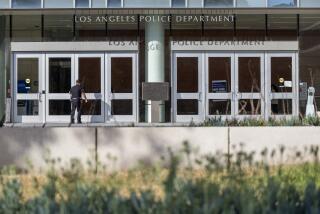Gates Refused to Issue Order on LAPD Use of Safety Belts Last June
- Share via
Los Angeles Police Chief Daryl F. Gates, who this week ordered all officers to buckle up both their shoulder and lap belts after a traffic accident that killed three officers, refused to approve the same regulation six months ago.
Gates’ decision in June to reject such an order led state safety officials to deny the Police Department’s request for an $829,407 grant that would have helped educate citizens and officers alike in the life-saving value of seat belts and shoulder restraints, The Times has learned.
The three officers were killed Monday when their two cruisers collided on a Skid Row street. They apparently were wearing neither lap belts nor shoulder restraints, which in Los Angeles police cars are not hooked together and can be worn separately. A fourth officer who had buckled both his lap and shoulder restraints survived the accident with only cuts and bruises.
Gates was out of town Wednesday and could not be reached for comment. But his spokesman, Cmdr. William Booth, said the chief’s earlier decision not to order officers to wear both lap and shoulder belts was based on complaints by officers that a seat belt and shoulder harness--a so-called three-point safety system--can be dangerously restrictive in an emergency.
“When you need to get out that car in a hurry, with the way that (shoulder harness) comes across, the potential for entanglement with the badge and the gun belt and ammunition pouches and so forth is there,” Booth said. “That is a significant issue among officers, and (Gates) wasn’t ready to force them to do it . . . (just) to get a grant.”
Booth said there is “absolutely no assurance” that any of the three officers who died Monday would have been saved had there been a requirement that they wear all of the safety restraints available to them in their patrol cars.
Other safety experts, however, suggested Wednesday that the accident might have been less tragic had the three officers--Derrick C. Connor, Manuel Gutierrez Jr. and David Hofmeyer--been properly buckled in.
Their two cars collided at 4 a.m. at the intersection of 5th and Wall streets when Gutierrez drove the wrong way on one-way 5th and broadsided a cruiser driven by Hofmeyer. All three officers suffered massive head injuries.
Craig Miller, regional program coordinator for the National Highway Traffic Safety Administration in San Francisco, said studies have shown that on average, victims in three out of 10 accidents avoid serious injury or death by wearing a lap belt. When a motorist wears both shoulder and lap belts, seven in 10 avoid death or serious injury, he said.
Miller also rejected the idea that shoulder belts pose a potential danger to officers in a hurry.
‘Red Herring’
“Quite frankly, that’s a red herring,” Miller said. “A lot of police agencies now use the three-point program and have no problem. It’s just a matter of the officer being trained correctly.”
The Los Angeles Police Department has had a standing policy for 20 years that officers wear lap belts, but most do not regularly abide by it, and the regulation has been rarely enforced.
Until recently, that has been the case with most other police departments in California too, but that situation is changing, according to officials of the state Office of Traffic Safety in Sacramento. The office issues funds to police agencies for safety-belt enforcement and education, among other programs.
Under the office’s guidelines, police agencies applying for grants for seat-belt education or enforcement first must require that their own personnel wear both lap and shoulder belts.
More than 25 California law enforcement agencies, including Buena Park, Glendale, Manhattan Beach and others in the Los Angeles area, have sought and received funding under the program after meeting the three-point policy requirement.
While the Los Angeles County Sheriff’s Department does not draw any grant money for seat-belt education or enforcement from the Office of Traffic Safety, it does require its personnel to wear lap and shoulder belts. The Santa Monica Police Department has such a requirement and, as of Jan. 1, the California Highway Patrol will have one.
No Policy
“To my knowledge, everybody that has requested funding had a three-point policy or issued one,” said Charles R. Ledbetter, the Office of Traffic Safety’s grant programs manager. “I don’t believe we’ve turned down anybody except for the (Los Angeles Police Department) because they did not have a policy.”
Ledbetter said that after the Los Angeles Police Department submitted its grant proposal, traffic safety officials contacted Gates’ office, asking if the department had a three-point safety-belt policy for personnel. Department officials responded that there was none.
In a terse letter sent to Gates in July rejecting the grant proposal, state Traffic Safety Director Peter K. O’Rourke noted that it would be “inappropriate and inconsistent for us to fund an agency to do occupant protection enforcement and education which is unable to set an example to the public it serves.
“If your policy changes, please contact our office to discuss your proposal further,” O’Rourke wrote.
Gates never responded, according to Ledbetter.
The Los Angeles Police Department grant proposal pointed out that only 30% of its patrol officers wear their restraining devices with any regularity, compared to 40% of the city’s motoring public.
Usage Rate
The stated objective of the proposed, two-year grant was to triple the seat-belt usage among officers by 1990, while increasing to 70% the public’s usage rate.
“Use of these devices can reduce more deaths and serious injuries than any enforcement campaign against any of the major contributors to traffic accidents,” the proposal stated. “To gain greater community compliance, studies have shown that law enforcement officers must wear their safety belts and enforce the safety-belt laws.”
Besides funding officer overtime pay for more stringent enforcement of seat-belt laws and more frequent educational presentations, the grant proposed that the state pay $60,000 for 3,000 engraved Cross pens to reward officers who wore their seat belts.
The grant also called for $200,000 to fund traffic safety kits for schoolchildren and membership cards in the Officer Snap Safety Program and $20,000 for a safety-belt van and trailer with which to distribute the safety kits.
On Wednesday, Booth said that the Police Department will likely try to “revive” the grant proposal now that Gates has revised department policy to include the wearing of shoulder restraints.
Among other major U.S. police departments surveyed by The Times, most require their officers to wear both shoulder harnesses and lap belts. One notable exception is New York City, where members of the nation’s largest police force are not obligated to wear even lap belts.
More to Read
Sign up for Essential California
The most important California stories and recommendations in your inbox every morning.
You may occasionally receive promotional content from the Los Angeles Times.










